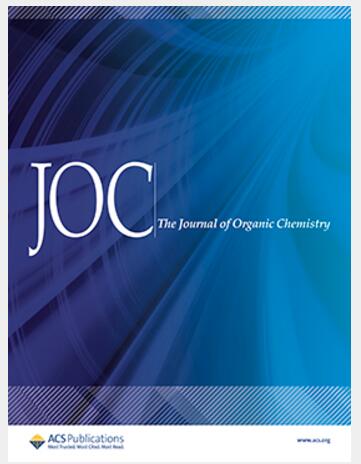氢键辅助Ru(III)催化1,3-二羰基的C-C键活化:合成多取代吡咯的直接途径
IF 3.6
2区 化学
Q1 CHEMISTRY, ORGANIC
Journal of Organic Chemistry
Pub Date : 2025-04-07
DOI:10.1021/acs.joc.5c0023310.1021/acs.joc.5c00233
引用次数: 0
摘要
据报道,在具有氧化还原活性的三胺配体(L1)和游离nh2臂的明确定义的Ru(III)-配合物(1)的催化下,1,3-二羰基和胺酮的CO-Cα键被前所未有地裂解,开辟了通过1,3-二羰基、胺和二醇的多组分偶联获得具有广泛底物范围和官能团耐受性的取代吡咯的新途径。1提供的氢键相互作用有利于关键反应中间体的形成,有利于吡咯的形成。本文章由计算机程序翻译,如有差异,请以英文原文为准。

Hydrogen-Bond-Assisted Ru(III)-Catalyzed C–C Bond Activation in 1,3-Dicarbonyls: A Direct Route to Multi-Substituted Pyrroles
Unprecedented CO–Cα bond cleavage of 1,3-dicarbonyls and enaminone, catalyzed by a well-defined Ru(III)-complex (1) featuring a redox-active triamine ligand (L1) with a free –NH2 arm, opening a new route to accessing substituted pyrroles with broad substrate scope and functional group tolerance in good isolated yields via multicomponent coupling of 1,3-dicarbonyls, amines, and diol, is reported. The hydrogen bonding interaction offered by 1 facilitates the formation of critical reaction intermediates, favoring the formation of pyrroles.
求助全文
通过发布文献求助,成功后即可免费获取论文全文。
去求助
来源期刊

Journal of Organic Chemistry
化学-有机化学
CiteScore
6.20
自引率
11.10%
发文量
1467
审稿时长
2 months
期刊介绍:
Journal of Organic Chemistry welcomes original contributions of fundamental research in all branches of the theory and practice of organic chemistry. In selecting manuscripts for publication, the editors place emphasis on the quality and novelty of the work, as well as the breadth of interest to the organic chemistry community.
 求助内容:
求助内容: 应助结果提醒方式:
应助结果提醒方式:


